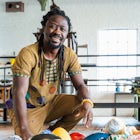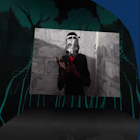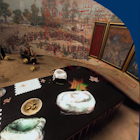The Panorama of Congo was commissioned by the Belgian Ministry of Colonies for the 1913 World Exposition (or World Fair) in Ghent, Belgium and to promote the Belgian territories in Congo. As an artwork and media object is it part of Belgium’s material colonial heritage. While it was created to promote Belgium’s endeavors in Belgian Congo, it also testifies to the power relationships and large scale and systematic destructions that are part of imperial processes.
Bringing such objects into the public realm, comes with great responsibilities. As a team we consider ‘decolonization’ to be an open-ended process. We have made an intervention in respect of one object and our work is not comprehensive. What we have tried to do is create a polyphony of voices around the Panorama to counter, criticize and deconstruct the original propaganda narrative. We have done so by involving academic experts, museum staff, and Afro descendant and African artists to partner with us in exploring the material form of colonial history. Their responses were captured through interviews, workshops, films and other artworks and VR experiences and can be accessed through the exhibition (both physical and virtual) and soon on this website.
We’re working on finishing the part of the website
To get notified when we are ready to launch this part, subscribe to the newsletter.
Participating artists

Deogracias Kihalu
Deogracias Kihalu (1982, Democratic Republic of Congo) focuses on the harmony between human being, nature and space, in which human being takes a central position. Deogracias explores themes such as decolonization, acceptance of the other, diversity, resilience and collective memory. There is no fixed medium in his work, so it always takes a different expression for the creation of spontaneous life forms.

“Past-Present”
My work has the same meaning as the “Panorama du Congo” in the sense that it crosses time to illustrate a period that is still present today. It shows that the past keeps us living in its continuous haunting.
The “Panorama du Congo” is like a pretty curtain in a house that hides its ugliness, or rather the atrocities that the colonial industry inflicted on the Congolese territory and the Congolese people.
My work overwrites colonial propaganda with real words: invasion (or occupation), capitalism in Congo, severed hands, veils, humiliation, trauma and so many others that I do not point out. The objective is to go through denunciation and resistance by touching the wound to clean it, to heal it by dialoging (kinzonzi) and by demanding the reparation which will lead us to resilience, a culture that we must not forget in order to reinvent our future.

Kongo astronauts
Kongo Astronauts, founded by Michel Ekeba and Eléonore Hellio in Kinshasa, explores the interzones of the Plantationocene, an era marked by the exploitation of natural resources, and forced labour on monoculture plantations. They examine forces that shape digital globalization and its impact on survival tactics in urban and rural contexts. Through cosmic apparitions and polysemous fictions, they prompt a systemic exploration of exile, bridging parallel worlds. Ekeba embodies KA through actions involving modified consciousness, urban drift, and telescoping. Crafting space suits from old electronic circuits loaded with extracted minerals, he activates them while traversing spaces across the continent and beyond. Hellio’s ongoing series, “Postcolonial Dilemmas,” interweaves human subjectivities and histories, positioning the spark of oneiric visions and real life in the long shadow of colonialism. In their trans-media practice, Kongo Astronauts reflects on human fragility amid the crisis of late capitalism.

“Waiting for the sun”
Bebson, a transonorous being, clicks the tongue of his metal mask. On the Kwenge River, a spacewalker continues his epic journey, along- side the ruined former Unilever plantation, pas- sing from one existential dimension to another. His visions expand. As a solar child of uncertain times, he seeks a new perspective and attempts to breathe new life into one that has been cons- tricted by a fragmented history. The memory of the forest’s tall trees still stirs beneath the waves.

Lukah Katangila
Lukah Katangila, choreographer, dancer and activist who mobilizes for the rights of Congolese children through a committed dance performance that transcends the cultures of the streets of Goma. He founded the project “Ndoto mchezo za watoto” (“Dream of Child dancers”) with his brothers and friends. As an artist, he experiments with the convergence of contemporary and ritual visual language and lets us discover his moving story. Katangila won the Roel Verniers Price 2020 for his dance solo Ndoto and he was a recipient of the Vocatio scholarship in 2021.

“Mbula”
In “Mbula”, Lukah Katangila offers dance as a ritual process in the same manner as his ancestors used to do to please the gods and bring rain. Spiritually charged, this piece suggests the connections between human beings and other elements of matter, as well as the fluid transitions between states: from liquid (water) to solid (ice) and back again; and then from liquid to gaseous (vapour).

Castélie Yalombo
Castélie Yalombo Lilonge is a Spanish-Belgian-Congolese artist. She graduated from ULB and holds a Master from the Higher Institute of Choreographic Arts of ARBAESA. Her artistic practice lies at the intersection of choreography, installation and poetic speech. Castélie questions the status of collective identity, otherness and relationship, as well as the subject/object status of the body. The artist raises awareness for the topics of decolonisation and the need for a re-articulation of the identity narratives in the network of forgotten, confiscated, hidden histories.

“Spectral Inheritance”
‘Spectral Inheritance’ is the invisible mass of affects, actions and non-actions passed on to descendants through break-ups, things left unsaid, absence and forgetting.
This ‘negative’ heritage is a request from our ancestors, a request to turn ghostly power into the power of life. Choose memory, not just history.
And so we accept our heritage by lending our voices and our bodies to our ghosts, so that their lives may be honoured. This animation is a “ghost’s word”, a choreographic performance about the ambivalence of bodies caught in a vice in the frictions and tensions that take place between the categories of belonging: the over there of origin, and the here, the place of lived experience. The artist visits narratives, memories and territories where her body is at play, suspended between the spectator’s gaze and her own subjectivity. Her body, the object that, despite herself, deposits stories of domination, displacement, exile and hope.

Hadassa Ngamba
Having grown up in Boma (the prototype of Congolese industrialization) and in Lubumbashi (a large mining town in the Haut-Katanga region, which before the colonization counted other kingdoms besides Congo), Hadassa started working with maps, which reveal the signs of exploitation. Ngamba moved to Brussels to participate in the residency programme at the WIELS, which was followed by a post-graduate course in visual arts at Ghent’s HISK. Her work is included in the collections of S.M.A.K., Ghent (BE); IKOB, Eupen (BE); the National Bank of Belgium, Brussels (BE); and the Morgan Stanley of Bank, New York (USA), international private collection. The work she exhibits was highlighted in an article in the New York Times.

“La table sereine de Sainte Thèse”
This artwork invites us to reflect on crony capitalism as a rational system of domination whose principles continue to manifest themselves, namely through the interest in various metals in the Democratic Republic of Congo and the inhumane means used to obtain them.
In this artwork, the table, a symbol of negotiations, coexists with other elements, including an interpretation of a colonial archive object: a diagram that recalls the hierarchical complexity and rationality of the system.
This work raises issues regarding religion, economics, knowledge/power systems and social justice. The interpretation of documents and symbols is accompanied by the inscription of personal memories and experiences, linking individual experience and collective memory in a way that is as intense as it is honest.
